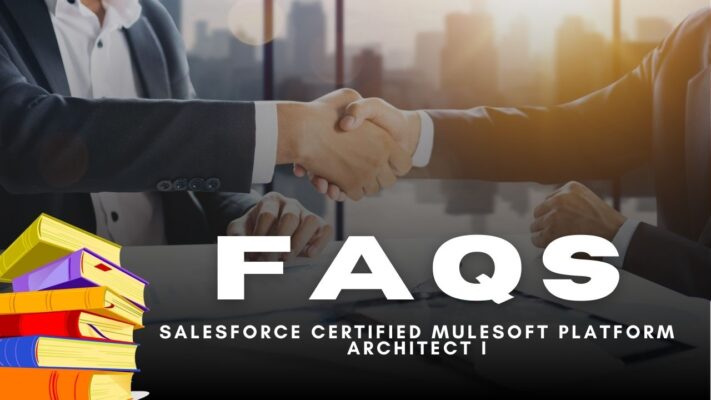Salesforce Certified MuleSoft Platform Architect I
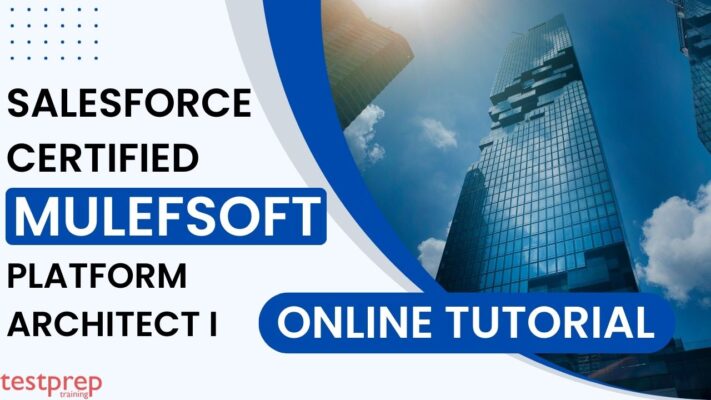
The Salesforce Certified MuleSoft Platform Architect I certification is designed for professionals experienced in shaping and overseeing an organization’s strategy for the Anypoint Platform. This certification equips individuals to guide the development of a cohesive application network, leveraging API-led connectivity with Anypoint Platform to integrate various solutions across the organization.
Knowledge Requirement
Candidates for the Salesforce Certified MuleSoft Platform Architect I certification have the expertise to:
- Optimize and tailor the Anypoint Platform deployment to fit the organization’s specific needs, collaborating with business, infrastructure, InfoSec, and other relevant teams.
- Define how the Anypoint Platform integrates with other tools and applications within the organization.
- Establish the platform’s usage guidelines and outline the organizational and process changes required to ensure its long-term sustainability.
- Lead the creation of standards, reusable assets, and automation necessary to support scaling and multi-line of business (LoB) adoption.
Exam Target Job Role
Common job titles for these candidates include Enterprise Architects and Solution Architects, who are well-versed in integration technologies, such as SOA, and have a foundational understanding of Anypoint Platform components.
Exam Details
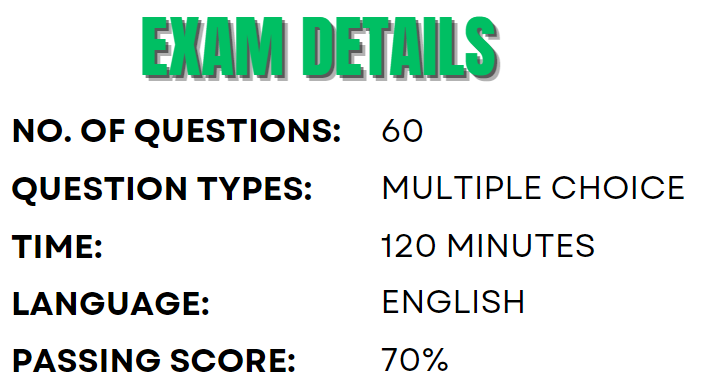
The Salesforce Certified MuleSoft Platform Architect I exam consists of 60 multiple-choice questions and up to five unscored questions, with a total time of 120 minutes allocated for completion, including the unscored questions. To pass, candidates must achieve a score of 70%. The exam is available either as a proctored test at a designated testing center or in an online environment, and no hard-copy or online materials may be used during the exam.
Course Outline
The Salesforce Certified MuleSoft Platform Architect I exam assesses a candidate’s expertise in several key areas. Candidates should have experience in shaping and managing an organization’s Anypoint Platform strategy. They must also have the ability to guide the development of a robust application network by integrating individual solutions through API-led connectivity, utilizing the Anypoint Platform across the organization. However, the major topics include:
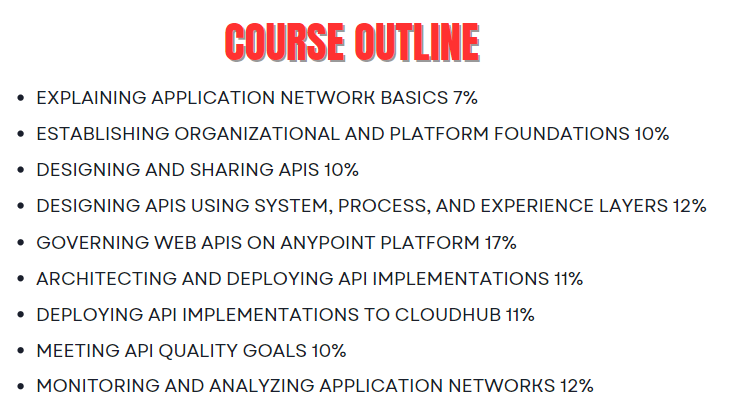
– Explaining application network basics 7%
- Identify and differentiate between technologies typically used to implement API-led connectivity.
- Describe the role and characteristics of web APIs.
- Correctly assign APIs to tiers according to ownership, functional focus, and rate of change.
- Describe the capabilities and high-level components of Anypoint Platform.
– Establishing organizational and platform foundations 10%
- Advise on establishing a Center for Enablement (C4E) and identify key performance indicators (KPIs) to measure its success.
- Describe the high-level structure and benefits of MuleSoft Catalyst.
- Compare and contrast Identity Management and Client Management options on Anypoint Platform.
- Identify data residency of different kinds of data (payload, metrics, and others).
– Designing and sharing APIs 10%
- Identify dependencies between an API, its API specification, its implementation, and its clients.
- Describe the creation and publication of reusable API-related assets using API specifications and Anypoint Platform components.
- Identify changes to an API that would require or not require changing the major/minor/patch component of its semantic version.
- Given a specific power relationship between two Bounded Contexts, choose the most appropriate strategy for mapping between the API data models of these Bounded Contexts.
- Identify idempotent HTTP methods and HTTP-native support for optimistic concurrency.
- Recognize the important features and functionality of API Designer to design API specifications.
– Designing APIs using System, Process, and Experience Layers 12%
- Identify appropriate APIs to implement a business process and assign them to layers of API-led connectivity.
- Assign APIs to layers according to ownership, functional focus, and rate of change.
- Recommend the most appropriate approach relating the API data model of System APIs to that of their backend system based on specific requirements and organizational characteristics.
– Governing web APIs on Anypoint Platform 17%
- Make appropriate use of API instances and environments in API Manager, taking into account the nature of the API and the underlying data and system.
- Select appropriate API policies and other components of the API to support specific non-functional requirements (NFRs).
- Identify any change(s) required to an API specification to reflect the application of an API policy with specific characteristics.
- Select an approach to API policy enforcement based on specific preferences and constraints, including, but not limited to, API proxies/API gateways and Anypoint Service Mesh.
- Secure web APIs using API policies appropriately chosen for the API’s tier (System, Process, Experience).
- Describe in what circumstances and how to pass client ID and secret to a web API.
- Explain how to request access to an API version for an API client, and how that access is approved and revoked.
- Select appropriate API policies to enforce non-functional security constraints on web API invocations.
- Explain the relationships of Anypoint Platform, external Identity Providers (IdPs), AP Business Groups, and API clients in the context of OAuth 2.0.
- Identify scenarios needing custom API policies.
– Architecting and deploying API implementations 11%
- Explain how to use auto-discovery to link a web API implementation to an API instance managed with API Manager.
- Identify requirements that call for the use of an Anypoint Virtual Private Cloud (VPC).
- Compare and contrast options for hosting and managing Anypoint Platform runtime planes.
- Compare unit and integration tests and specify where MUnit is best employed.
- Explain options for automated building, testing, and deployment of API implementations and related artifacts in a DevOps setting.
– Deploying API implementations to CloudHub 11%
- Describe the scenarios for which Object Store (OS) should be used with CloudHub.
- Select CloudHub worker sizes and configuration as appropriate.
- Given an app deployed to the CloudHub shared worker cloud in one or more regions, describe and predict its reliability and performance characteristics.
- Identify the defining differences between the CloudHub Shared and Dedicated Load Balancers.
- Compare and contrast the options for CloudHub networking in the presence of customer-owned Amazon VPCs and on-premises data centers.
- Identify and avoid single points of failure in CloudHub deployments of API implementations.
– Meeting API quality goals 10%
- Design, describe, and differentiate between scenarios that use an OS or caching.
- Select resilience strategies that help web API clients guard against failures when invoking APIs.
- Describe when horizontal scaling of an API implementation is or is not likely to benefit response time and throughput as seen by API clients.
– Monitoring and analyzing application networks 12%
- Identify the components of Anypoint Platform that generate data for monitoring and alerting.
- Describe the metrics collected by Anypoint Platform for API invocations.
- Specify alerts to define for key metrics of API invocations for all layers of API-led connectivity.
- Specify alerts to define for Mule applications.
Salesforce Certified MuleSoft Platform Architect I: FAQs
Salesforce Exam Candidate Code of Conduct
By participating in the Salesforce Credentialing Program, you must agree to the terms outlined in the Salesforce Credential and Certification Program Agreement.
Participants in the Salesforce Credentialing Program are expected to:
- Use official Salesforce study resources on Trailhead, including exam guides, trail mixes, and Trailhead courses to prepare for certification exams.
- Engage with the Trailblazer Community to find additional training, collaborate with peers, and connect with study groups or mentors.
- Follow the rules for both online proctored and in-person certification exams.
- Report any activity that compromises credential security to the Credential Security team.
Participants in the Salesforce Credentialing Program are prohibited from:
- Sharing, using, or seeking out certification exam questions and answers, or superbadge solutions.
- Requesting, offering, or accepting assistance during your certification exam.
- Engaging in any activity that violates the Salesforce Credential and Certification Program Agreement.
Violations of the Program Agreement may result in:
- Cancellation of upcoming exams.
- Suspension from taking online proctored exams.
- Ban from participating in any certification exams.
- Revocation of existing certifications and superbadges.
- Removal from the Salesforce Credentialing Program and the Trailblazer Community.
Salesforce Certified MuleSoft Platform Architect I Study Guide
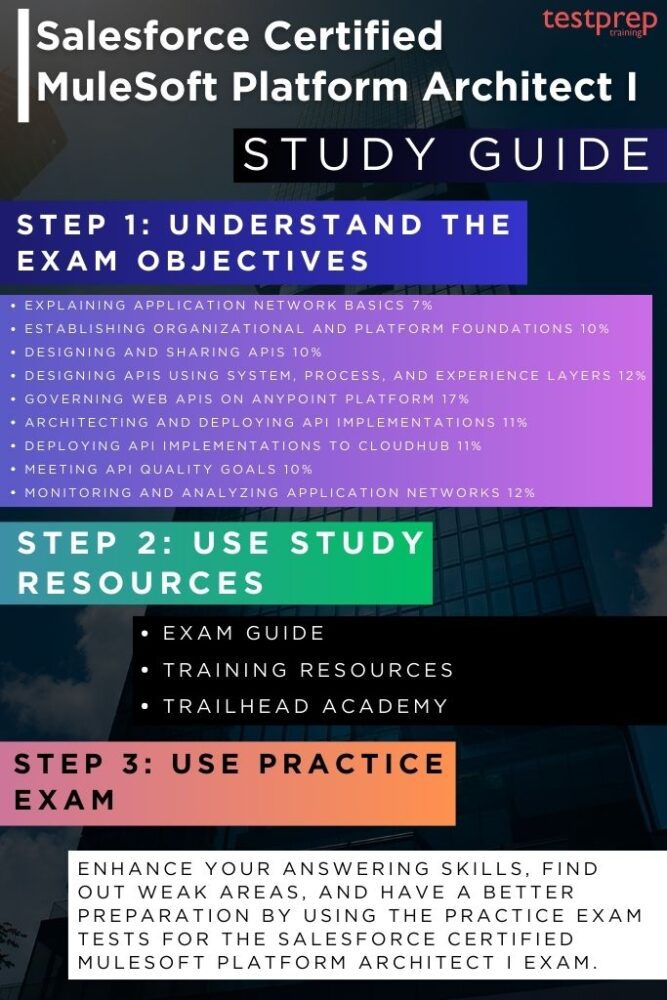
1. Understand the Exam Guide
The Salesforce exam guide is specifically designed to help you assess whether you’re prepared to complete the Salesforce Certified MuleSoft Platform Architect I exam. This comprehensive guide outlines essential information, including the target audience for the exam, recommended training resources, and a full list of the exam objectives, all aimed at helping you achieve a passing score. The guide provides insights into the knowledge and skills required for the role, ensuring that candidates are equipped to handle the responsibilities associated with the MuleSoft Platform Architect I certification.
It highlights the importance of understanding key concepts like Anypoint Platform strategy, API-led connectivity, and the development of scalable, reusable application networks across an organization. Salesforce strongly recommends a well-rounded preparation approach, which includes gaining real-world, hands-on experience in the field, attending relevant training courses, and engaging in thorough self-study using official documentation and resources.
2. Use Recommended Training and Resources
Salesforce suggests combining practical experience, completion of training courses, engagement with Trailhead trails, and targeted self-study in the areas outlined in the Exam Outline. For self-study, use the following resources:
- Practice Exam: Salesforce MuleSoft Platform Architect I Practice Exam
- This practice exam allows you to get accustomed to the format and types of questions you may face on the actual test. The questions reflect the style and difficulty of the real exam. By self-scoring your results, you can pinpoint your strengths and weaknesses, helping you concentrate on the areas that need further attention.
3. Utilize Salesforce Trailhead Academy
Using Salesforce Trailhead Academy for your preparation for the Salesforce Certified MuleSoft Platform Architect I exam is an effective strategy to enhance your knowledge and skills. Trailhead Academy offers a variety of tailored courses and learning paths specifically designed to cover the essential concepts and best practices related to the MuleSoft platform. Engaging with these interactive resources allows you to learn at your own pace, with hands-on challenges that reinforce your understanding of key topics. Additionally, Trailhead provides access to a community of learners and experts, enabling you to seek guidance, share experiences, and gain insights from those who have successfully passed the exam. Furthermore, the course that will help in better exam preparation include:
– Anypoint Platform Architecture: Application Networks (ARC720)
The Anypoint Platform Architecture: Application Networks course is designed to teach you how to create an application network using API-led connectivity with the MuleSoft Anypoint Platform. For three days in an instructor-led format, you will learn to construct a robust application network by integrating various solutions to connect applications, data, and devices through APIs.
Who Should Attend?
- This course is intended for senior solution architects and enterprise architects tasked with developing application networks using API-led connectivity on the MuleSoft Anypoint Platform.
- It is also ideal for individuals aiming to earn their MuleSoft Platform Architect I certification.
- Participants should have the MuleSoft Developer I credential or have equivalent experience, including previous roles as an architect for cloud-based software development projects.
- A solid understanding of software development for the Java Virtual Machine is essential.
- Familiarity with enterprise integration concepts—such as interface definitions and contracts, data encoding in XML or JSON, REST APIs, or SOAP web services—is also important.
- Knowledge of query languages, message-passing (using Java Message Service, Advanced Message Queuing Protocol, or similar), and network protocols (including TCP, IP, HTTP, and HTTPS) is required.
- Additionally, students should have a foundational understanding of the Anypoint Platform, key security concepts like certificates and encryption, and common components of enterprise and cloud technology architecture, including identity providers, load balancers, and name servers.
4. Become Part of Study Groups/Communities
Joining study groups and communities dedicated to the Salesforce Certified MuleSoft Platform Architect I exam can significantly enhance your preparation experience. These collaborative environments offer a wealth of resources, including shared knowledge, study materials, and diverse perspectives that can deepen your understanding of complex topics. By engaging with fellow candidates and experienced professionals, you can participate in discussions, exchange tips, and clarify doubts, which can help reinforce your learning.
Many communities also organize study sessions, webinars, and mock exams, providing structured opportunities for practice and feedback. Networking with others in these groups can also lead to valuable connections within the MuleSoft ecosystem, offering insights into industry trends and best practices. Overall, becoming part of a study group or community fosters a supportive learning atmosphere that can motivate you and help you stay accountable on your journey to achieving certification.
5. Take Practice Exam Tests
Taking practice exam tests for the Salesforce Certified MuleSoft Platform Architect I exam is a crucial step in your preparation journey. These practice exams simulate the actual testing experience, allowing you to become familiar with the format, question types, and difficulty level of the real exam. By working through these tests, you can assess your knowledge of key concepts and identify areas where you may need further study.
Practice exams not only help you reinforce your understanding but also improve your time management skills, as you learn to navigate the questions within the allotted time. After completing each practice test, you can review your results to understand your strengths and weaknesses, enabling you to tailor your study plan accordingly. This feedback loop is invaluable for boosting your confidence and readiness as you approach the certification exam.


